#vogue 1926
Explore tagged Tumblr posts
Text

Eduardo Garcia Benito, Art Deco, Vogue Cover, New York in Summer, July 15th 1926
#Eduardo Garcia Benito#illustration#art deco#art#1926#vogue cover#painting#20s#vintage#1920s#1926 illustrations#jazz age#the roaring twenties#summer#summer issue#july issue#vogue 1926#july 1926#cover art#art deco illustration#red#mirror#hand mirror#magazine#magazine cover#vogue magazine#art deco cover
149 notes
·
View notes
Photo


1926 Georges Lepape, The September issue—always in style. Vogue, September 15, 1926.
#1926#illustration#cover#vogue cover#1926 vogue#1926 vogue cover#the september issue#1926 the september issue#in style#always in style#lepape#vogue
11 notes
·
View notes
Text






DOUGLAS FAIRBANKS in THE BLACK PIRATE — 1926, dir. Albert Parker The most celebrated sequence of the film, and perhaps of Fairbanks's entire career, is the moment in which the Black Pirate, when capturing a galleon single-handedly, slashes a line with his knife, catches the end of the mizzen, and swings upward with the wayward sail to the main topsail. He then plunges his knife in to the canvas of the topsail and slides down the sail, supported by the hilt of his knife as it severs the canvas in half. He rends the mainsail in the same manner. The feat is so spectacular that Fairbanks repeats it once more with the fore topsail, rendering the ship powerless. The Black Pirate swings through the lines to the forecastle, swivels about a pair of cannons he has commandeered, and holds the crew as helpless as the galleon itself.
The sliding down the sails is a grand stunt, building on Robin Hood's celebrated descent down the enormous drapery in Robin Hood [1922]. The 43-year-old showman is in top physical form, and the appearance of effortlessness, the breathtaking arcs of movements, and the sheer joy with which he accomplishes the impossible are ample demonstrations of Fairbanks's kinetic genius.
The sequence was achieved with separate sail sets engineered by Robert Fairbanks on the back lot, apart from various ship settings, and erected on an angle away from the cameras (which were also on an angle). The sails, according to Douglas Fairbanks, Jr., were "pre-sliced and then stitched up invisibly. . . .The knife was rigged with piano wire, pulley, and counterweight. . . .He would thrust his knife into the sail and there would be a quick cut. The next cut would be of him holding the special knife connected to the hidden pulley and counterweight."
Airplane propellers behind the canvas provided the billowing effect for the sails. As with all of his stunts, Fairbanks wore a wire harness, and his arms and legs were taped to prevent friction burns. Although no one doubted at the time that he performed the stunt, William K. Everson later maintained that Fairbanks did not do so himself. But the accounts of Albert Parker, Douglas Fairbanks, Jr., and Chuck Lewis and the surviving outtakes from the scene itself dispel any claim that Fairbanks did not perform his most famous feat. Fairbanks's bravura stunt was subsequently pirated by a stunt double for Errol Flynn in Against All Flags (1952) and by Orlando Bloom in Pirates of the Caribbean 2: Dead Man’s Chest (2006).
One of the immediate effects of the famous sequence was all the injuries sustained by impressionable children imitating their screen idol. Edward Wagenknecht wrote, "One shudders to think how many broken arms and legs he must have been responsible for among the children of America during the years of his vogue." Robert Parrish, a future director and film editor, was one such child. He recalled having seen The Black Pirate in his hometown of Columbus, Georgia, and immediately wanting to emulate the spectacular Fairbanks stunt:
"As a seven-year-old, I had seen Douglas Fairbanks in The Black Pirate plunge a knife into the sail and riding the knife down to the deck. I tried the knife stunt myself that afternoon with a borrowed linen bed sheet. Some friends and I attached it to the limb of an oak tree about ten feet off the ground. I climbed the tree with a butcher's knife in my mouth trying to smile like Fairbanks—I soon tasted blood in my mouth—and pointed the knife at the sheet and jumped. The sheet crashed down upon me like a deflated parachute and the knife flew out of my hand. I landed on the ground with a broken arm, the wind knocked out of me, and blood running from my Fairbanks grin."
#userteri#usermichi#marciabrady#userviet#filmedit#film#classicfilmedit#oldhollywoodedit#Douglas Fairbanks#The Black Pirate#1920s#ours#by Jackie
212 notes
·
View notes
Text
121 Words & Phrases for Dying
A remarkable creativity surrounds the vocabulary of death. The words and expressions range from the solemn and dignified to the jocular and mischievous.
Old English
swelt/forswelt ⚜ give up the ghost ⚜ dead ⚜ i-wite
wend ⚜ forworth ⚜ go out of this world ⚜ quele ⚜ starve
c.1135 — 1600s
die (c.1135) ⚜ fare (c.1175) ⚜ end; let; shed (one’s own) blood (c.1200)
yield (up) the ghost (c.1290) ⚜ take the way of death (1297)
die up; fall; fine; leave; spill; tine (c.1300)
leese one’s life-days (c.1325) ⚜ part (c.1330)
flit (c.1340) ⚜ trance; pass (1340) ⚜ determine (c.1374)
disperish (c.1382) ⚜ be gathered to one’s fathers (1382)
miscarry (c.1387) ⚜ go; shut (1390)
expire; flee; pass away; seek out of life; sye; trespass (c.1400)
decease (1439) ⚜ ungo (c.1450) ⚜ have the death (1488)
vade (1495) ⚜ depart (1501) ⚜ pay one’s debt to nature (c.1513)
galp (1529) ⚜ go west (c.1532) ⚜ pick over the perch (1532)
die the death (1535) change one’s life; jet (1546)
play tapple up tail (1573) ⚜ inlaik (1575) ⚜ finish (1578) ⚜ relent (1587)
unbreathe (1589) ⚜ transpass (1592) ⚜ lose one’s breath (1596)
go off (1605) ⚜ make a die (of it) (1611) ⚜ fail (1613)
go home (1618) ⚜ drop (1654) ⚜ knock off (c.1657) ⚜ ghost (1666)
go over to the majority (1687) ⚜ march off (1693)
bite the ground/sand/dust; die off; pike (1697)
1700s — 1960s
pass to one’s reward (1703) ⚜ sink; vent (1718) ⚜ demise (1727)
slip one’s cable (1751) ⚜ turf (1763) ⚜ move off (1764)
kick the bucket (1785) pass on (1805) exit (1806)
launch into eternity (1812) ⚜ go to glory (1814) ⚜ sough (1816)
hand in one’s accounts (1817) ⚜ croak (1819)
slip one’s breath (1819) ⚜ stiffen (1820) ⚜ buy it (1825)
drop short (1826) ⚜ fall a sacrifice to (1839)
go off the hooks (1840) ⚜ succumb (1849) ⚜ step out (1851)
walk (forth) (1858) ⚜ snuff out (1864) ⚜ go/be up the flume (1865)
pass out (c.1867) ⚜ cash in one’s checks (1869) ⚜ peg out (1870)
go bung (1882) ⚜ get one’s call (1884) ⚜ perch (1886) ⚜ off it (1890)
knock over (1892) ⚜ pass in (1904) ⚜ the silver cord is loosed (1911)
pip (out) (1913) ⚜ cop it (1915) ⚜ stop one (1916) ⚜ conk (out) (1918)
cross over (1920) ⚜ kick off (1921) ⚜ shuffle off (1922)
pack up (1925) ⚜ step off (1926) ⚜ take the ferry (1928)
meet one’s Maker (1933) ⚜ kiss off (1945)
have had it (1952) ⚜ crease it (1959) ⚜ zonk (1968)
The list displays a remarkable inventiveness, as people struggle to find fresh forms of expression.
The language of death is inevitably euphemistic, but few of the verbs or idioms shown here are elaborate or opaque.
In fact the history of verbs for dying displays a remarkable simplicity: 86 of the 121 entries (over 70%) consist of only one syllable, and monosyllables figure largely in the multi-word entries (such as pay one’s debt to nature).
Only 16 verbs are disyllabic, and only 3 are trisyllabic (determine, disperish, miscarry), loanwords from French, and along with expire, trespass, and decease showing the arrival of a more scholarly vocabulary in the 14th and 15th centuries.
Even the euphemisms of later centuries have a markedly monosyllabic character.
Some constructions evidently have permanent appeal because of their succinct and enigmatic character, such as the popularity of ‘____ it’ (whatever the ‘it’ is): snuff it, peg it, buy it, cop it, off it, crease it, have had it.
It’s possible to see changes in fashion, such as the vogue for colloquial usages in "off" in the middle of the 18th century (move off, pop off, pack off, hop off ).
And styles change: we no longer feel that "pass out" would be appropriate on a tombstone. But some things don’t change. Pass away has been with us since the 14th century. And, in a usage that dates back to the 12th, we still do say that people, simply, died.
Source ⚜ More: Word Lists ⚜ Notes & References ⚜ Historical Thesaurus
#writing reference#writeblr#dark academia#spilled ink#langblr#literature#writers on tumblr#linguistics#writing prompt#poets on tumblr#poetry#writing prompts#language#words#creative writing#writing inspiration#writing resources
129 notes
·
View notes
Text


1919 Designer Lucile called herself "the mother of the Russian boot" and Vogue, Harper's Bazar etc. did attribute much of the trend to her inspiration and example. Above is Lucile in a pair of Russian boots and below is Clara Bow in 1926 in the silent film "Kid Boots" wearing, of course, Russian boots. From Lucile, Her Life by Design, FB.
66 notes
·
View notes
Text

Cover of the July 15, 1926 issue of American Vogue, featuring "New York in Summer." Illustration by Eduardo García Benito.
Photo: Fine Art America
#vintage New York#1920s#vintage magazines#Eduardo García Benito#Vogue#Vogue cover#vintage Vogue#vintage illustration#Art Deco#July 15#15 July#vintage magazine cover
101 notes
·
View notes
Text
What's In a Pocchiri? Part 19
On The Eleventh Day of Fun I present... another pocchiri! Unlike the last one, this one is still owned by an active okiya, so let's dive in!

Image courtesy of Exciting Japan. Materials: Silver, Quartz, Carnelian, Jade, Pearl, and Rhodochrosite Motif(s): Flowers and Leaves Owned By: Masamiya (雅美家) in Pontocho This is one stand out pocchiri! Not only does it feature a very large carving, which is uncommon, but it also has imported materials, which is rare! The base itself is silver, with the leaves in the middle, the flower petals along the bottom, and the leaves under the pearls to the side also being made of silver. The centers of the flowers along the bottom are carnelian, a stone whose hues can range from red to orange to yellow. There's also a singular carnelian bead in the top center of the piece. On top of that lone carnelian bead at the top is a rectangular piece of jade. Jade has long since held importance in Asian cultures, especially Japan, for millennia, and provides a nice contrast to the carnelian. To the right of the jade sits a cluster of pearls, which have been farmed off the coast of Japan longer than jade has been mined, making them prized for trading and decoration since before written history. On the left we have the massive carving of a rose! It's made from some type of quartz, likely a white quartz, and is very chic. Rose motifs were in vogue during the Taisho Period (1912 - 1926) and it's possible that this is where the craftsperson who made it drew inspiration from. It's also possible that the rose was originally a singular pocchiri on its own and then dismantled and added onto in order to make a larger, more modern pocchiri. Finally, the last stone is imported from outside of Japan and is extremely unusual in pocchiri: rhodochrosite. This stone isn't found much in fine jewelry as it's not clear or bright like popular stones, but rather has striations throughout that alternate between pink and white. It's added into this piece to look like a leaf. Here we can see it being worn on maiko Hidemio (秀澪):

Image courtesy of Diabolos.
#maiko#geiko#geisha#kyoto#pocchiri#rose#silver#jade#pearl#rhodochrosite#quartz#舞妓#芸妓#芸者#京都#ぽっちり#帯留め#バラ#銀
35 notes
·
View notes
Text

Edward Steichen - Marion Morehouse Wearing a Dress by Chanel (Vogue 1926)
#edward steichen#marion morehouse#vogue#photography#fashion photography#vintage fashion#vintage style#vintage#retro#aesthetic#beauty#20s#20s fashion#20s model#roaring twenties#1920s#1920s fashion#jazz age#editorial#chanel
262 notes
·
View notes
Text
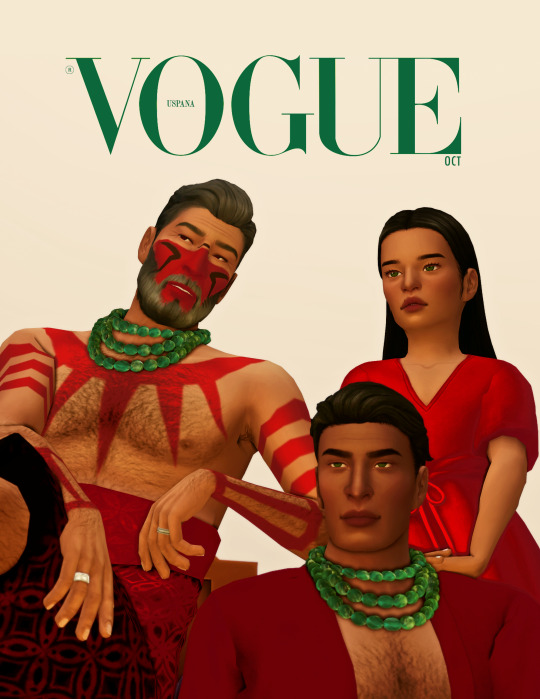
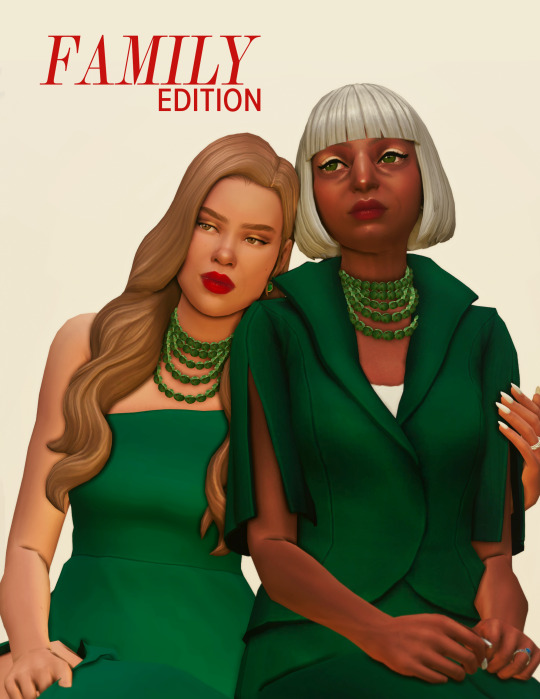
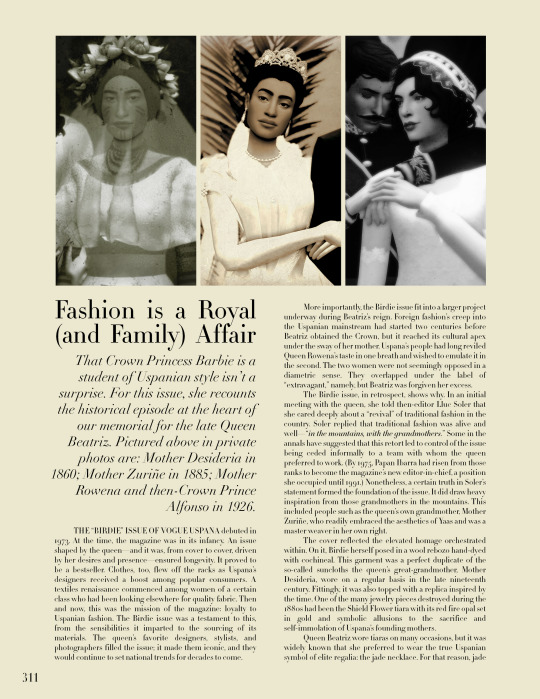
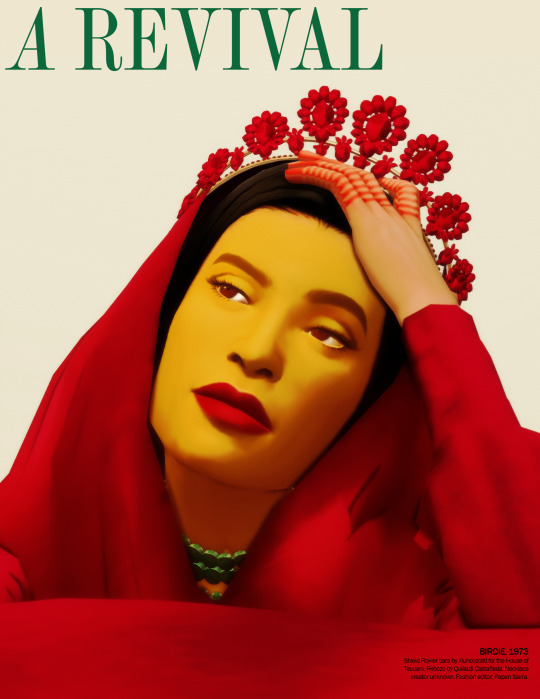
have been feeling listless and unmoored re: sims stuff lately, but i got a healthy dose of inspiration from @warwickroyals & @prydainroyals this past week, so i did a little succession / magazine-ish thing :^) obviously beatriz's 2023 death would be commemorated in uspanian vogue !!!!! obviously !!!!
transcribed text below:
Fashion is a Royal (and Family) Affair
That Crown Princess Barbie is a student of Uspanian style isn’t a surprise. For this issue, she recounts the historical episode at the heart of our memorial for the late Queen Beatriz. Pictured above in private photos are: Mother Desideria in 1860; Mother Zuriñe in 1885; Mother Rowena and then-Crown Prince Alfonso in 1926.
THE “BIRDIE” ISSUE OF VOGUE USPANA debuted in 1973. At the time, the magazine was in its infancy. An issue shaped by the queen—and it was, from cover to cover, driven by her desires and presence—ensured longevity. It proved to be a bestseller. Clothes, too, flew off the racks as Uspana’s designers received a boost among popular consumers. A textiles renaissance commenced among women of a certain class who had been looking elsewhere for quality fabric. Then and now, this was the mission of the magazine: loyalty to Uspanian fashion. The Birdie issue was a testament to this, from the sensibilities it imparted to the sourcing of its materials. The queen’s favorite designers, stylists, and photographers filled the issue; it made them iconic, and they would continue to set national trends for decades to come. More importantly, the Birdie issue fit into a larger project underway during Beatriz’s reign. Foreign fashion’s creep into the Uspanian mainstream had started two centuries before Beatriz obtained the Crown, but it reached its cultural apex under the sway of her mother. Uspana’s people had long reviled Queen Rowena’s taste in one breath and wished to emulate it in the second. The two women were not seemingly opposed in a diametric sense. They overlapped under the label of “extravagant,” namely, but Beatriz was forgiven her excess. The Birdie issue, in retrospect, shows why. In an initial meeting with the queen, she told then-editor Lluc Soler that she cared deeply about a “revival” of traditional fashion in the country. Soler replied that traditional fashion was alive and well—“in the mountains, with the grandmothers.” Some in the annals have suggested that this retort led to control of the issue being ceded informally to a team with whom the queen preferred to work. (By 1975, Papan Ibarra had risen from those ranks to become the magazine’s new editor-in-chief, a position she occupied until 1991.) Nonetheless, a certain truth in Soler’s statement formed the foundation of the issue. It did draw heavy inspiration from those grandmothers in the mountains. This included people such as the queen’s own grandmother, Mother Zuriñe, who readily embraced the aesthetics of Yaas and was a master weaver in her own right. The cover reflected the elevated homage orchestrated within. On it, Birdie herself posed in a wool rebozo hand-dyed with cochineal. This garment was a perfect duplicate of the so-called suncloths the queen’s great-grandmother, Mother Desideria, wore on a regular basis in the late nineteenth century. Fittingly, it was also topped with a replica inspired by the time. One of the many jewelry pieces destroyed during the 1880s had been the Shield Flower tiara with its red fire opal set in gold and symbolic allusions to the sacrifice and self-immolation of Uspana’s founding mothers. Queen Beatriz wore tiaras on many occasions, but it was widely known that she preferred to wear the true Uspanian symbol of elite regalia: the jade necklace. For that reason, jade
BIRDIE, 1973 Shield Flower tiara by Xiuhcozcatl for the House of Tecuani. Rebozo by Quilatzli Castañeda. Necklace creator unknown. Fashion editor: Papan Ibarra.
#this wasn't gonna be a whole thing#but i decided Why Not#this is what the kids call worldbuilding after all :^)#rip queen birdie )^:#no but why are the vogue layouts kinda ugly sdfkdsg#ch.arnaut#ch.german#ch.malena#ch.barbie#ch.lorraine#ch.beatriz#reyes.worldbuilding#n.mediastuff
132 notes
·
View notes
Text

Eduardo Garcia Benito, Vogue Cover, French Edition, Les Modes pour L'Automne, Art Deco Fashion Illustration, 1 July 1926
#Eduardo Garcia Benito#illustration#1926#vogue cover#1920s#cover illustration#art deco#vintage#fashion#20s#pearls#smoking#cigarettes#smoking hot#paris#art deco illustration#art#french edition#parisian mode#mode#chic#parisian chic#july issue#yacht#luxury yacht#yachtlife#painting#my edit#edits
132 notes
·
View notes
Text

Vogue colouring book, published in 2016, on the cover an illustration from the January 1926 Vogue cover by André Marty
#moda 365#fashion#fashion blog#fashion blogger#fashion lover#fashion photography#vintage#vintage fashion#vogue#colouring#colouring book#coloring book#coloring#vintage style#illustrator#fashion illustration#fashion illustrator#andre marty
36 notes
·
View notes
Text
1920s Fashion – No Fringe
It's historically inaccurate to assume that every dress for evening had fringe. In perusing old photographs online, there are a few here and there but most of the photographs that exist today show women wearing classic 20s fashions without fringe.
Dropped waists became popular and were evident from street clothes to evening dresses. The new woman or flapper was starkly different from the women of the past. She was carefree and more independent, preferring clothing that was easy to move in. The term "flapper" wasn't exclusively used to describe women who danced daringly to jazz music but to describe this woman of the 20s as she flapped her new wings to embark upon a new era.
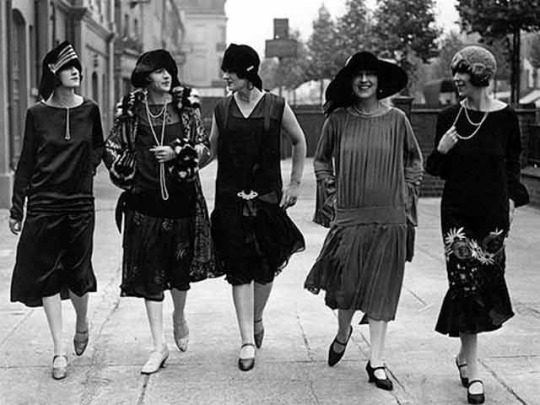
1920s urban socialites
Let's not forget that the iconic designer of the 1920s was Coco Channel. Among her contributions to the fashion world was the invention of The Little Black Dress.

The drawing on the right was featured on the cover of Vogue, 1926



1920s evening dresses by Callot-Souer
#fashion history#1920s fashion#coco chanel#little black dress#vogue magazine#women's fashion#flapper girl#callot-souer#fashion design#french fashion designer#the resplendent outfit
35 notes
·
View notes
Text
From BA's website:
The Masquerades of Spring Further Reading
The Weary Blues, Langston Hughes (1926)
Infants in the Spring, Wallace Thurman (1932)
Strange Brother, Blair Niles (1931)
Voices of the Harlem Renaissance (originally as The New Negro: An Interpretation), Ed. Alain Locke (1925)
Ma Rainey’s Black Bottom, August Wilson,(1981)
The Harlem Renaissance: A Very Short Introduction, Cheryl A. Wall (2016)
Hart The Big Sea, Langston Hughes (1940)
Harlem Stomp: A Cultural History of the Harlem Renaissance, Leban Carrick Hill (2003)
Taxi! A Social History of the New York City Cabdriver, Graham Russell Gao Hodges (2007)
When Harlem Was In Vogue, David Levering Lewis (1979)
Harlem Renaissance, Ed. Rafia Zafar (2011)
The Scene of Harlem Cabaret, Shane Vogel (2009)
Gay New York, George Chauncey (1994)
20 notes
·
View notes
Text

藪蔓小豆[Yabutsuruazuki] Vigna angularis var. nipponensis
藪[Yabu] : Thicket, bush
蔓[Tsuru] : Vine
小豆[Azuki] : Adzuki, V. angularis var. angularis
It is a annual vine plant and produces yellow flowers about two centimeters in diameter that bloom at this time of year. The flowers of the family Fabaceae are usually butterfly-shaped and symmetrical, but that of Yabutsuruazuki is twisted, making its shape difficult to check. As such, its flower language is "Perverseness".
This is said to be the original variety of Azuki, and according to those who have eaten it, it is equally tasty. However, the bean is very small, about four millimeters long, so it will be difficult to harvest the required amount. https://en.wikipedia.org/wiki/Adzuki_bean
As an aside, during the Taishō era(1912-1926), glamorous colors were in vogue. When I read novels from or set in that time period, often get images of Azuki-iro(adzuki bean color). This color was also one of them. https://www.google.com/search?q=taisho+era+fashion&udm=2 https://www.youtube.com/watch?v=8jKWTtParRE
16 notes
·
View notes
Text

October, 1926 Cover of "Vogue", the British version, art by Eduardo Benito. From Art Deco, Avant Garde and Modernism, FB.
100 notes
·
View notes
Text

Noire et Blanche (French for Black and White) is a black and white photograph taken by American visual artist Man Ray in 1926. It is one of his most famous photographs at the time when he was an exponent of Surrealism.
The picture was first published in the Parisian Vogue magazine, on 1 May 1926, with the title Visage de Nacre et Masque d'Ébene. It would be published once again with the current title in the French magazines Variétés and Art et Décoration in 1928.
Man Ray had already published a similar photograph in the cover of the Dada magazine of Francis Picabia, with the title Black and White, in 1924, depicting two statuettes, one European and classical and the other African.
#man ray#surrealism#fashion vintage#vintage#1930s style#surrealist art#1920s#retro movies#retro style
28 notes
·
View notes